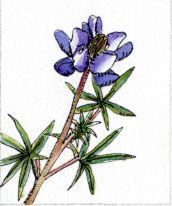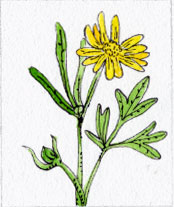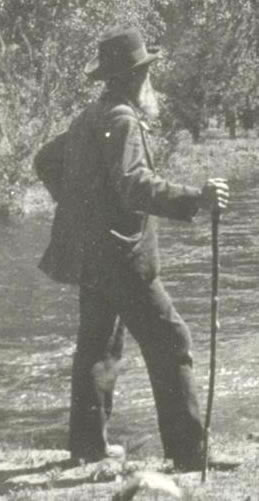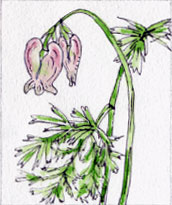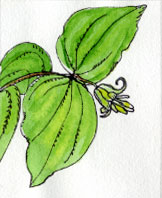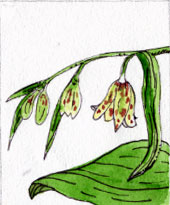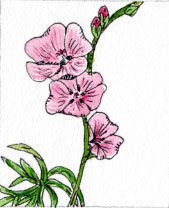III. Pacheco Pass
A letter to Bro. David: July 1868:
A letter to the Merrills: July 1868:
A letter to Mrs. Carr: July 1868:
The scenery, too, and all of Nature in the pass is fairly enchanting, strange and beautiful mountain ferns, low in the dark caņons and high upon the rocky, sunlit peaks, banks of blooming shrubs, and sprinklings and gatherings of [ ] flowers, precious and pure as ever enjoyed the sweets of a mountain home. And oh, what streams are there! beaming, glancing, each with music of its own, singing as they go in the shadow and light, onward upon their lovely changing pathways to the sea; and hills rise over hills, and mountains over mountains, heaving, waving, swelling, in most glorious, overpowering, unreadable majesty; and when at last, stricken with faint like a crushed insect, you hope to escape from all the terrible grandeur of these mountain powers, other fountains, other oceans break forth before you, for there, in clear view, over heaps and rows of foot hills is laid a grand, smooth outspread plain, watered by a river, and another range of peaky snow-capped mountains a hundred miles in the distance. That plain is the valley of the San Joaquin, and those mountains are the great Sierra Nevadas.
Rambles of a Botanist: 1872
…The Pacheco Pass was scarcely less enchanting than the valley. It resounded with crystal waters, and the loud shouts of thousands of California quails. In size these about equal the eastern quail; not quite so plump in form. The male has a tall, slender crest, wider at top than bottom, which he can hold straight up, or droop backward on his neck, or forward over his bill, at pleasure; and, instead of Bob White, he shouts: "pe-check-a," bearing down with a stiff, obstinate emphasis on "check."
Through a considerable portion of the pass the road bends and mazes along the groves of a stream, or down in its pebbly bed, leading one now deep in the shadows of dogwoods and alders, then out in the light, through dry chaparral, over green carex meadows banked with violets and ferns, and dry, plantless flood-beds of gravel and sand.
We found ferns in abundance all through the pass. Some far down in dark canons, as the polypodium and rockfern, or high on sunlit braes, as Pelloea mucronata. Also we observed the delicate gold-powdered Gynmogramma triangularis, and Pelloea andromedoefolia, and the maidenhair (Adiantum chilense), and the broad-shouldered bracken (Pteris aquilina), which is everywhere; and an aspidium and cystopteris, and two or three others that I was not acquainted with. Also in this rich garden pass we gathered many fine grasses and carices, and brilliant penstemons, azure and scarlet, and mints and lilies, and scores of others, strangers to us, but beautiful and pure as ever enjoyed the sun or shade of a mountain home.
The summit of this pass, according to observations made by the State geological survey, is fourteen hundred and seventy-two feet above the sea. Pacheco Peak, on the south side of the pass, is two thousand eight hundred and forty-five feet high, sharp, and capped with trachyte. It forms an excellent landmark for the San Joaquin and San Jose valleys for a great distance; and I have frequently seen it from the summit of El Capitan and Sentinel Dome, Yosemite. Mt. Hamilton, north of the pass, and easily reached from the town of San Jose, is two thousand four hundred and forty-eight feet in height. San Carlos Peak, some distance to the south, is nearly five thousand feet high, and is about the highest point on the Monte Diablo range.
After we were fairly over the summit of the pass, and had reached an open hill-brow, a scene of peerless grandeur burst suddenly upon us. At our feet, basking in sungold, lay the Great Central Plain of California, bounded by the mountains on which we stood, and by the lofty, snow-capped Sierra Nevada; all in grandest simplicity, clear and bright as a new outspread map.
Pelican Bay manuscript 1907:
The Yosemite: 1912
Looking eastward from the summit of the Pacheco Pass one shining morning, a landscape was displayed that after all my wanderings still appears as the most beautiful I have ever beheld. At my feet lay the Great Central Valley of California, level and flowery, like a lake of pure sunshine, forty or fifty miles wide, five hundred miles long, one rich furred garden of yellow Composito. And from the eastern boundary of this vast golden flower-bed rose the mighty Sierra, miles in height, and so gloriously colored and so radiant, it seemed not clothed with light, but wholly composed of it, like the wall of some celestial city. Along the top and extending a good way down, was a rich pearl-gray belt of snow; below it a belt of blue and lark purple, marking the extension of the forests; and stretching long the base of the range a broad belt of rose-purple; all these colors, from the blue sky to the yellow valley smoothly blending as they do in a rainbow, making a wall of light ineffably fine. Then it seemed to me that the Sierra should be called, not the Nevada or Snowy Range, but the Range of Light. And after ten years of wandering and wondering in the heart of it, rejoicing in its glorious floods of light, the white beams of the morning streaming through the passes, the noonday radiance on the crystal rocks, the flush of the alpenglow, and the irised spray of countless waterfalls, it still seems above all others the Range of Light.
1000 Mi Walk: 1916
…The scenery, too, and all of nature in the Pass is fairly enchanting. Strange and beautiful mountain ferns are there, low in the dark canons and high upon the rocky sunlit peaks; banks of blooming shrubs, and sprinklings and gatherings of garment flowers, precious and pure as ever enjoyed the sweets of a mountain home. And oh! what streams are there! beaming, glancing, each with music of its own, singing as they go, in shadow and light, onward upon their lovely, changing pathways to the sea. And hills rise over hills, and mountains over mountains, heaving, waving, swelling, in most glorious, overpowering, unreadable majesty.
When at last, stricken and faint like a crushed insect, you hope to escape from all the terrible grandeur of these mountain powers, other fountains, other oceans break forth before you; for there, in clear view, over heaps and rows of foothills, is laid a grand, smooth, outspread plain, watered by a river, and another range of peaky, snow-capped mountains a hundred miles in the distance. That plain is the valley of the San Joaquin, and those mountains are the great Sierra Nevada…
Life and Letters: 1924
The Pacheco Pass was scarcely less enchanting than the valley. It resounded with crystal waters, and the loud shouts of thousands of quails. The California quail is a little larger than the Bob White; not quite so plump in form. The male has a tall, slender crest, wider at top than bottom, which he can hold straight up, or droop backward on his neck, or forward over his bill, at pleasure; and, instead of "Bob White," he shouts "pe-check-a," bearing down with a stiff, obstinate emphasis on check." Through a considerable portion of the pass the road bends and mazes along the groves of a stream, or down in its pebbly bed, leading one now deep in the shadows of dogwoods and alders, then out in the light, through dry chaparral, over green carex meadow banked with violets and ferns, and dry, plantless flood-beds of gravel and sand.
We found ferns in abundance in the pass . . . Also in this rich garden pass we gathered many fine grasses and carices, and brilliant penstemons, azure and scarlet, and mints and lilies, and scores of others, strangers to us, but beautiful and pure as ever enjoyed the sun or shade of a mountain home.
At this point Muir's unpublished memoirs resume the thread of the narrative as follows:
At the top of the Pass I obtained my first view of the San Joaquin plain and the glorious Sierra Nevada. Looking down from a height of fifteen hundred feet, there, extending north and south as far as I could see lay a vast level flower garden, smooch and level like a lake of gold--the floweriest part of the world I had yet seen. From the eastern margin of the golden plain arose the white Sierra. At the base ran a belt of gently slopingpurplish foothills lightly dotted with oaks, above that a broad dark zone of coniferous forests and above is forest zone arose the lofty mountain peaks, clad in snow. The atmosphere was so clear that the nearest of the mountain peaks on the axis of range were at a distance of more than one hundred and fifty miles, they seemed to be at just the right distance to be seen broadly in their relations to one another, marshaled in glorious ranks and groups, their snowy robes smooch and bright that it seemed impossible for a man to walk across the open folds without being seen, even at this distance. Perhaps more than three hundred miles of the range was comprehended in this one view.
Descending the pass and wading out into the bed of golden compost five hundred miles long by forty or fifty wide, I found that the average depth of the vegetation was over knee deep, and the flowers were so crowded together that in walking through the midst of them and over them more than a hundred were pressed down beneath the foot at every step. The yellow these compositae, both of the ray and disc flowers, is extremely deep a rich and bossy, and exceeds the purple of all the others in superficial quantity forty or fifty times their whole amount. But to an observer who first looks downward, then takes a wider and wider view, the yellow gradually fade and purple predominates, because nearly all of the purple flowers are taller, In depth, the purple stratum is about ten or twelve inches, the yellow seven or eight, and down in the shade, out of sight, is another stratum of purple, one inch in depth, for the ground forests of mosses are there, with purple stems, and purple cups. The color beauty of these mosses, at least in mass, was not made for human eyes, nor for the wild horses that inhabit these plains, nor the antelopes, but perhaps the little creatures enjoy their own beauty, and perhaps the insects that dwell in these forests and climb their shining columns enjoy it. But we know that however faint, and however shaded' no part of it is lost, for all color is received into the eyes of God.
The Pacheco Pass was scarcely less enchanting than the valley. It resounded with crystal waters, and the loud shouts of thousand of California quails, In size these about equal the eastern quail; not quite so plump in form. The male has a tall, slender crest, wider at top than bottom, which he can hold straight up, or droop backward on his neck, or forward over his bill, at pleasure; and, instead of Bob White, he shouts: "pe-check-a," bearing down with a stiff, obstinate emphasis on "check."
Through a considerable portion of the pass the road bends and mazes along the groves of a stream, or down in its pebbly bed, leading one now deep in the shadows of dogwoods and alders, then out in the light, through dry chaparral, over green carex meadows banked with violets and ferns, and dry plantless floed-beds of gravel and sand.
We found ferns in abundance all through the pass. Some far down in dark canons, as the polypodium and rock-fern, or high on sunlit braes, as Pelloea mucronata, Also we observed the delicate gold-powdered Gynmogramma triangularis, and Peloea andromedoefolia, and the maidenhair ( Adiantum chilense), and the broadshouldered bracken (Pteris aquilina), which is everywhere; and an aspidium and cystopteris, and two or three others that I was not acquainted with. Also in this rich garden pass we gathered many fine grasses and carices, and brilliant penstemons, azure and scarlet, and mints and lilies, and scores of others, strangers to us , but beautiful and pure as ever enjoyed the sun or shade of a mountain home.
The summit of this pass, according to observations made by the State Geological survey , is fourteen hundred and seventy-two feet above the sea. Pacheco Peak, on the south side of the pass, is two thousand eight hundred and forty-five feet high, sharp, and capped with trachyte. It forms an excellent landmark for the San Joaquin and San Jose valleys for a great distance; and I have frequently seen it from the summit of El Capitan and Sentinel Dome, Yosemite. Mt. Hamilton, north of the pass, and easily reached from the town of San Jose, is two thousand four hundred and forty-eight feet in height. San Carlos Peak, some distance to the south, is nearly five thousand feet high, and is about the highest point on the Monte Diablo range, After we were fairly over the summit of the pass, and had reached an open hill-brow, a scene of peerless grandeur burst suddenly upon us. At our feet, basking in sungold, lay the reat Central Plain of California, bounded by the mountains on which we stood, and by the lofty, snowcapped Sierra Nevada; all in grandest simplicity, clear and bright as a new outspread map.
Son of the Wilderness: 1946
The air was 'throbbing with lark song" as they struck off eastward from Gilroy toward Pacheco Pass. From this height Muir looked down upon "the floweriest piece of world" he had ever seen.
